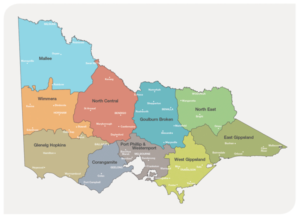 Putting Victoria’s fungal biodiversity on the map
Putting Victoria’s fungal biodiversity on the map
We were delighted to receive a Victorian Government Biodiversity On-ground Action grant of $50,000 in late 2017 for a project until 2020 which will focus on fungi in eight Victorian Catchment Management areas over the next two years. These are:
- East Gippsland (May 2019)
- Port Phillip & Westernport (2018)
- North Central (2018)
- Goulburn-Broken (2018)
- Corangamite (Jun 2019)
- Glenelg Hopkins (Jun 2019)
- West Gippsland ( May 2019)
- Wimmera (Aug 2019)
We are (for updates and downloads of kits):
- developing region-specific education kits
- run workshops and field trips for:
- citizen scientists in collection of recognisable fungi data
- 15 species that are rare or threatened (lost) fungi
- provide support for ongoing species identification checking using highly experienced Fungimap volunteers
These will help communities record their local fungi species – those that are recognisable and those that are thought to be rare or threatened.
Those data records will help clarify distribution, species abundance and pinpoint areas needing further research. Once the project is underway, we will encourage groups to share their knowledge with others in their community.
 J Eichler CC BY-SA
J Eichler CC BY-SA
Tea-tree Fingers project
Hypocreopsis amplectens – Tea-tree Fingers is a rare fungus and the only fungus listed under the Victorian Flora & Fauna Guarantee Act 1988 and is considered “vulnerable”. It was discovered in 1992 at Nyora, Vic. during a survey of plants.
Recent surveys suggest it has disappeared from one of the three known locations on the Mornington Peninsula and Gippsland, Victoria. We were funded by the Victorian State Government in 2016 to find out where it lives and to map the species so that an action plan can be developed for its survival and recovery. It may also warrant inclusion on national threat status lists in Australia and New Zealand.
In July 2017 the largest known population of Tea-tree Fingers was discovered at Wanderslore sanctuary at Launching Place, Vic by the Field Naturalists Club of Victoria. As reported in the FNCV newsletter:
The discovery is noteworthy for several reasons, including:
- This is the first new Victorian location for Hypocreopsis in the 25 years since the initial batch of discoveries were made Yarra Burgan (Kunzea leptospermoides) is a newly recorded host and the habitat is somewhat different to other known Victorian sites.
- This is a more inland site than the known, near coastal Victorian sites.
- This discovery demonstrates that a wider range of habitats and hosts should be checked for the presence of this fungus, e.g. Warrandyte and Neds Gully in the Cathedral Range.
- Most specimens from Launching Place were actively growing, while those from other know Victorian locations have either died out or are declining.
We hope to undertake population studies and continue to work towards better conservation of Tea-tree Fingers, which has also been found at:
- a Yarra Valley, Victoria, site on a new host plant, Yarra Burgan (Kunzea leptospermoides).
- the original site in Adams Creek Nature Conservation Reserve, Lang Lang, near Nyora,Vic during some surveys by Biosis. To our great relief, 5-7 living individuals were observed – the first time for several years.
The habitat for Tea-tree Fingers is long-unburnt, heathy woodland with stands of tea tree, banksia and melaleuca species which have reached a height in excess of 3 meters.
If you are interested in contributing to this project, you can:
- learn to recognise Tea-tree Fingers using our booklet
- prepare and ‘rich’ data record, including its host fungi – see example here
- upload a record on the ALA’s Biocollect project for Tea-tree Fingers
And if you think you have seen Tea-tree Fingers but are unsure, please email us at: fungimapconservation@gmail.com.
See here for the latest update.


